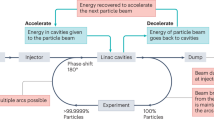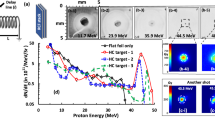Abstract
Conventional electron linear accelerators are essential research tools but limited in providing high beam currents. Energy recovery technology enables high beam currents with reasonable and sustainable power supply requirements by recycling the electrons’ kinetic energy. Independently, higher beam energies can be achieved if electrons are accelerated multiple times in a linear accelerator. The combination of both techniques results in a multi-turn energy recovery linear accelerator, which is capable of providing high beam power. Here we report the demonstration of efficient energy recycling in multi-turn operation where we saved up to 87% of the consumed beam power in the main linear accelerator of the superconducting Darmstadt electron linear accelerator (S-DALINAC). In this setting, the cumulative phase slippage effect, caused by the different speeds of the electrons per main linear accelerator pass and the resulting different interactions with the alternating electric field, cannot be neglected and was compensated. Our proof-of-principle demonstration shows how multi-turn energy recovery linear accelerators can outperform conventional machines due to the potential for considerable power saving while providing higher beam power.
This is a preview of subscription content, access via your institution
Access options
Access Nature and 54 other Nature Portfolio journals
Get Nature+, our best-value online-access subscription
$29.99 / 30 days
cancel any time
Subscribe to this journal
Receive 12 print issues and online access
$209.00 per year
only $17.42 per issue
Buy this article
- Purchase on Springer Link
- Instant access to full article PDF
Prices may be subject to local taxes which are calculated during checkout



Similar content being viewed by others
Data availability
The experimental data presented in this manuscript are available from a TUdatalib repository43. Source data are provided with this paper.
Code availability
The codes that support the findings of this study are available from a TUdatalib repository37.
References
Abela, R. et al. XFEL: The European X-Ray Free-Electron Laser - Technical Design Report (DESY, 2006).
Mishin, A. V. Advances in X-band and S-band linear accelerators for security, NDT, and other applications. In Proc. Particle Accelerator Conference 2005 (ed. Horak, C.) 240–244 (JACoW Publishing, Geneva, 2005).
Lee, Y. S. et al. Development of side-coupled X-band medical linear accelerator for radiotherapy. In Proc. Linear Accelerator Conference 2018 (eds Pei, G. et al.) 139–141 (JACoW Publishing, Geneva, 2019).
Accardi, A. et al. Electron ion collider: the next QCD frontier. Eur. Phys. J. A 52, 268 (2016).
Agostini, P. et al. The Large Hadron–Electron Collider at the HL-LHC. J. Phys. G 48, 110501 (2021).
Litvinenko, V. N., Roser, T. & Chamizo-Llatas, M. High-energy high-luminosity e+e− collider using energy-recovery linacs. Phys. Lett. B 804, 135394 (2020).
Tigner, M. A possible apparatus for electron clashing-beam experiments. Nuovo Cim. 37, 1228–1231 (1965).
Merminga, L., Douglas, D. R. & Krafft, G. A. High-current energy-recovering electron linacs. Annu. Rev. Nucl. Part. Sci. 53, 387–429 (2003).
Klein, M. et al. in European Strategy for Particle Physics – Accelerator R&D Roadmap (ed. Mounet, N.) Ch. 6 (CERN, 2022).
Schriber, S. O. & Heighway, E. A. Double pass linear accelerator – reflexotron. IEEE Trans. Nucl. Sci. 22, 1060–1064 (1975).
Brau, C. A., Boyd, T. J., Cooper, R. K. & Swenson, D. A. High efficiency free-electron laser systems. In Proc. International Conference on Lasers 1979 (ed. Corcoran, V. J.) 26–32 (STS Press, 1980).
Flanz, J. B. & Sargent, C. P. Tests with an isochronous recirculation system. IEEE Trans. Nucl. Sci. 32, 3213–3215 (1985).
Smith, T. I., Schwettman, H. A., Rohatgi, R., Lapierre, Y. & Edighoffer, J. Development of the SCA/FEL for use in biomedical and materials science experiments. Nucl. Instrum. Methods Phys. Res. A 259, 1–7 (1987).
Bogacz, A. et al. CEBAF energy recovery experiment. In Proc. Particle Accelerator Conference 2003 (ed. Chew, J.) 195–197 (JACoW Publishing, Geneva, 2003).
Hajima, R. et al. First demonstration of energy-recovery operation in the JAERI superconducting linac for a high-power free-electron laser. Nucl. Instrum. Methods Phys. Res. A 507, 115–119 (2003).
Antokhin, E. A. et al. First lasing at the high-power free electron laser at Siberian Center for Photochemistry Research. Nucl. Instrum. Methods Phys. Res. A 528, 15–18 (2004).
Neil, G. R. et al. The JLab high power ERL light source. Nucl. Instrum. Methods Phys. Res. A 557, 9–15 (2006).
Alexander, J. et al. Progress on the commissioning of ALICE, the energy recovery linac-based light source at Daresbury Laboratory. In Proc. Particle Accelerator Conference 2009 (ed. Comyn, M.) 1281–1283 (JACoW Publishing, Geneva, 2009).
Akemoto, M. et al. Construction and commissioning of the compact energy-recovery linac at KEK. Nucl. Instrum. Methods Phys. Res. A 877, 197–219 (2018).
Arnold, M. et al. First operation of the superconducting Darmstadt linear electron accelerator as an energy recovery linac. Phys. Rev. Accel. Beams 23, 020101 (2020).
Gulliford, C. et al. Measurement of the per cavity energy recovery efficiency in the single turn Cornell–Brookhaven ERL Test Accelerator configuration. Phys. Rev. Accel. Beams 24, 010101 (2021).
Abo-Bakr, M. et al. The Berlin energy recovery linac project bERLinPro – status, plans and future opportunities. In Proc. ICFA Advanced Beam Dynamics Workshop on Energy Recovery Linacs 2019 (eds Meseck, A. et al.) 8–13 (JACoW Publishing, Geneva, 2020).
Vinokurov, N. A. et al. Novosibirsk free electron laser: operation and second stage commissioning. In Proc. Russian Particle Accelerator Conference 2008 (eds Kuzin, M. V. et al.) 181–184 (JACoW Publishing, Geneva, 2008).
Shevchenko, O. A. et al. Commissioning status and further development of the Novosibirsk Multiturn ERL. In Proc. ICFA Advanced Beam Dynamics Workshop on Energy Recovery Linacs 2013 (eds Kuzin, M. V. et al.) 6–10 (JACoW Publishing, Geneva, 2013).
Bartnik, A. et al. CBETA: first multipass superconducting linear accelerator with energy recovery. Phys. Rev. Lett. 125, 044803 (2020).
Pérez Segurana, G., Bailey, I. R. & Williams, P. H. Construction of self-consistent longitudinal matches in multipass energy recovery linacs. Phys. Rev. Accel. Beams 25, 021003 (2022).
Koscica, R., Banerjee, N., Hoffstaetter, G. H., Lou, W. & Premawardhana, G. Energy and rf cavity phase symmetry enforcement in multiturn energy recovery linac models. Phys. Rev. Accel. Beams 22, 091602 (2019).
Schließmann, F. et al. Beam dynamics simulations for the twofold ERL mode at the S-DALINAC. In Proc. ICFA Advanced Beam Dynamics Workshop on Energy Recovery Linacs 2019 (eds Meseck, A. et al.) 155–158 (JACoW Publishing, Geneva, 2020).
Arnold, M. et al. First ERL operation of S-DALINAC and commissioning of a path length adjustment system. In Proc. International Particle Accelerator Conference 2018 (eds Koscielniak, S. et al.) 4859–4862 (JACoW Publishing, Geneva, 2018).
Steinhorst, M. et al. RF average power measurement system at the S-DALINAC. Nucl. Instrum. Methods Phys. Res. A 1010, 165567 (2021).
Bogacz, S. A. et al. ER@CEBAF: a test of 5-pass energy recovery at CEBAF (BNL, 2016).
Hug, F. et al. Status of the MESA ERL project. In Proc. ICFA Advanced Beam Dynamics Workshop on Energy Recovery Linacs 2019 (eds Meseck, A. et al.) 14–17 (JACoW Publishing, Geneva, 2020).
Kaabi, W. et al. PERLE: a high power energy recovery facility. In Proc. International Particle Accelerator Conference 2019 (eds Boland, M. et al.) 1396–1399 (JACoW Publishing, Geneva, 2019).
Pietralla, N. The institute of nuclear physics at the TU Darmstadt. Nucl. Phys. News 28, 4–11 (2018).
Piot, P., Douglas, D. R. & Krafft, G. A. Longitudinal phase space manipulation in energy recovering linac-driven free-electron lasers. Phys. Rev. ST Accel. Beams 6, 030702 (2003).
Borland, M. elegant: a Flexible SDDS-Compliant Code for Accelerator Simulation (APS, 2000).
Schliessmann, F. et al. 2D beam-dynamics simulations code for the twofold energy-recovery mode at S-DALINAC. TUdatalib https://doi.org/10.48328/tudatalib-963 (2022).
Hug, F., Burandt, C., Konrad, M., Pietralla, N. & Eichhorn, R. Measurements of a reduced energy spread of a recirculating linac by non-isochronous beam dynamics. In Proc. Linear Accelerator Conference 2012 (eds Draper, M. et al.) 531–533 (JACoW Publishing, Geneva, 2012).
Jackson, F., Angal-Kalinin, D., Saveliev, Y. M., Williams, P. H. & Wolski, A. Longitudinal transport measurements in an energy recovery accelerator with triple bend achromat arcs. Phys. Rev. Accel. Beams 19, 120701 (2016).
Konrad, M. et al. Digital base-band rf control system for the superconducting Darmstadt electron linear accelerator. Phys. Rev. ST Accel. Beams 15, 052802 (2012).
Burandt, C. et al. The EPICS-based accelerator control system of the S-DALINAC. In Proc. of International Conference on Accelerator & Large Experimental Physics Control Systems 2013 (eds Marshall, C. et al.) 332–335 (JACoW Publishing, Geneva, 2013).
Savitzky, A. & Golay, M. J. E. Smoothing and differentiation of data by simplified least squares procedures. Anal. Chem. 36, 1627–1639 (1964).
Schliessmann, F. et al. Data set for the twofold energy-recovery mode at S-DALINAC. TUdatalib https://doi.org/10.48328/tudatalib-964 (2022).
Acknowledgements
We thank J. Enders and F. Hug for discussions and assistance. This work was supported by the German Research Foundation within the research training group GRK 2128 AccelencE (project ID 264883531) (F.S., M.A., L.J., N.P., M.D., M.F., R.G., M.S., L.S. and S.W.), the German Federal Ministry for Education and Research under grant no. 05H21RDRB1 (F.S., M.A., L.J., N.P. and M.D.) and the State of Hesse under the grant Nuclear Photonics within the LOEWE programme (M.A., N.P. and M.S.) and within the Hessian Research Cluster Project ELEMENTS (project ID 500/10.006) (M.A., L.J., N.P., M.F. and R.G.).
Author information
Authors and Affiliations
Contributions
M.A. and N.P. conceived the project. F.S., M.A. and L.J. designed the experiments. F.S., L.J., M.D., M.F., R.G., M.S., L.S. and S.W. performed the experiments and collected the data. F.S. and M.S. analysed the experimental data. F.S. carried out the simulations. F.S., M.A., L.J., N.P. and M.S. wrote the paper with contributions from all the authors. All the authors contributed to the experiments and discussion.
Corresponding author
Ethics declarations
Competing interests
The authors declare no competing interests.
Peer review
Peer review information
Nature Physics thanks Peter Williams and Yue Hao for their contribution to the peer review of this work.
Additional information
Publisher’s note Springer Nature remains neutral with regard to jurisdictional claims in published maps and institutional affiliations.
Extended data
Extended Data Fig. 1 Simulated longitudinal phase space along the accelerator.
Visualization of the momentum deviation, Δp, and time deviation, Δt, relative to the centroid values. Each frame provides the value for the location, s, as well as a description of the location behind which the plotted phase space is present. Cavity j in main-LINAC pass i is indicated as ‘Cavity (i,j)’. In this figure, a recirculation (rec.) ends directly in front of the first cavity of the main LINAC. In the last two frames, the correlated phase space at first entry into the main LINAC is compared to the phase space after maximum acceleration and at the end of the last main-LINAC pass, respectively.
Extended Data Fig. 2 Simulated longitudinal quantities along the accelerator.
Visualization of the centroid momentum, \(\bar p\), the momentum spread, σδ, and the bunch length, σt, as function of the location, s, starting after the injector LINAC. The bunch length is changing due to different velocities of the electrons and due to different path lengths of the electrons caused by the longitudinal dispersion. The effect of the longitudinal dispersion is implemented in the simulations by elements of zero length at the end of the corresponding sections.
Source data
Source Data for Fig. 3
Source Data
Source Data Extended Data Fig. 1
Source Data
Source Data Extended Data Fig. 2
Source Data
Rights and permissions
Springer Nature or its licensor (e.g. a society or other partner) holds exclusive rights to this article under a publishing agreement with the author(s) or other rightsholder(s); author self-archiving of the accepted manuscript version of this article is solely governed by the terms of such publishing agreement and applicable law.
About this article
Cite this article
Schliessmann, F., Arnold, M., Juergensen, L. et al. Realization of a multi-turn energy recovery accelerator. Nat. Phys. 19, 597–602 (2023). https://doi.org/10.1038/s41567-022-01856-w
Received:
Accepted:
Published:
Issue Date:
DOI: https://doi.org/10.1038/s41567-022-01856-w
This article is cited by
-
Strive towards sustainability
Nature Physics (2023)
-
Energy-recovery linacs for energy-efficient particle acceleration
Nature Reviews Physics (2023)
-
A route to greener Big Science
Nature Physics (2023)



